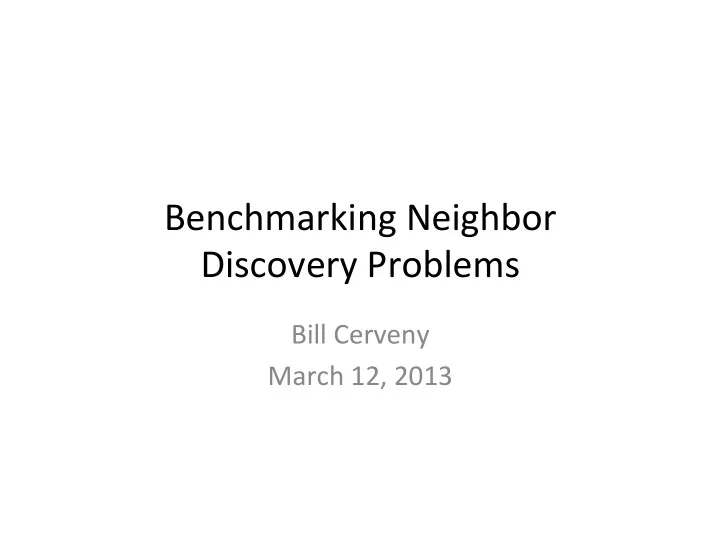

Benchmarking ¡Neighbor ¡ Discovery ¡Problems ¡ Bill ¡Cerveny ¡ March ¡12, ¡2013 ¡
History ¡ • Suggested ¡by ¡Ron ¡Bonica ¡at ¡IETF ¡85 ¡BMWG ¡ meeKng ¡
Neighbor ¡Discovery ¡(ND) ¡Problem ¡ Background ¡ • The ¡problem ¡is ¡described ¡and ¡documented ¡in ¡ RFC ¡6583, ¡“OperaKonal ¡Neighbor ¡Discovery ¡ Problems.” ¡ • An ¡IPv4 ¡subnet ¡is ¡“typically” ¡no ¡larger ¡than ¡ 510 ¡addresses ¡and ¡scanning ¡is ¡relaKvely ¡quick. ¡ • Since ¡the ¡default ¡size ¡of ¡any ¡IPv6 ¡user ¡subnet ¡ is ¡2**64, ¡there ¡can ¡be ¡a ¡lot ¡of ¡addresses ¡ • Scanning ¡the ¡IPv6 ¡subnet ¡takes ¡a ¡really ¡long ¡ Kme, ¡but ¡one ¡can ¡sKll ¡start ¡scanning ¡it. ¡
ND ¡Problem ¡con’t ¡ • The ¡number ¡of ¡addresses ¡one ¡can ¡scan ¡for ¡is ¡ limited ¡only ¡by ¡the ¡available ¡bandwidth. ¡ • The ¡DUT ¡(router) ¡needs ¡to ¡perform ¡ND ¡for ¡the ¡ addresses ¡being ¡scanned, ¡even ¡if ¡the ¡ addresses ¡aren’t ¡“live” ¡in ¡the ¡subnet ¡ • This ¡can ¡create ¡a ¡lot ¡of ¡state ¡in ¡the ¡DUT, ¡so ¡ much ¡so ¡that ¡the ¡DUT ¡may ¡be ¡unable ¡to ¡ complete ¡ND ¡for ¡real, ¡valid ¡nodes ¡in ¡subnet. ¡
Benchmarking ¡ND ¡Problem ¡ • Build ¡a ¡network ¡which ¡illustrates ¡ND ¡problem ¡ for ¡DUT. ¡ • Instrument ¡network ¡to ¡measure ¡DUT ¡behavior ¡ under ¡a ¡scan ¡which ¡causes ¡DUT ¡to ¡be ¡ overwhelmed ¡by ¡ND ¡triggering ¡events. ¡
Basic ¡Test ¡Network ¡and ¡Methodology ¡
More ¡comprehensive ¡Test ¡Network ¡ Scanner Network Node ::2 Target Network Node Scanner ::2 Network Target ::1 ::1 Network ::1 ::3 Non- participating Network ::1 ::2 ::2 Non-participating Network Remote Node Network Node
Metrics ¡/ ¡Measurements ¡ in ¡“00” ¡document ¡ 1. Round ¡trip ¡Kme ¡across ¡DUT ¡(easy) ¡ 2. Rate ¡DUT ¡add ¡valid ¡node ¡to ¡neighbor ¡cache ¡(medium) ¡ 3. Adherence ¡to ¡NDP ¡acKvity ¡prioriKzaKon ¡described ¡in ¡ RFC ¡6583 ¡(medium) ¡ 4. DUT ¡CPU ¡UKlizaKon ¡(easy ¡to ¡measure, ¡accuracy ¡ suspect) ¡ 5. Rate ¡DUT ¡forwards ¡packets(easy) ¡ 6. Rate ¡DUT ¡responds ¡to ¡neighbor ¡solicitaKons ¡in ¡ presence ¡of ¡scanning ¡acKvity ¡(medium) ¡ 7. Impact ¡on ¡unaffected ¡interfaces/subnets ¡ 8. Maximum ¡number ¡of ¡entries ¡in ¡DUT ¡
Proposed ¡metrics/measurements ¡ 1. Frequency ¡of ¡ND ¡triggering ¡events ¡sufficient ¡for ¡DUT ¡to ¡be ¡impaired ¡ (easy) ¡– ¡key ¡to ¡test ¡ 2. Round ¡trip ¡Kme ¡across ¡DUT ¡(easy) ¡ 3. Rate ¡DUT ¡adds ¡valid ¡node ¡to ¡neighbor ¡cache ¡(medium) ¡ 4. Adherence ¡to ¡NDP ¡acKvity ¡prioriKzaKon ¡described ¡in ¡RFC ¡6583 ¡ (medium) ¡– ¡ Relevant ¡but ¡perhaps ¡compliance, ¡not ¡benchmarking ¡ 5. Rate ¡DUT ¡forwards ¡packets(easy) ¡– ¡ Is ¡this ¡significant ¡in ¡ND ¡test? ¡ 6. Rate ¡DUT ¡responds ¡to ¡neighbor ¡solicitaKons ¡in ¡presence ¡of ¡ scanning ¡acKvity ¡(medium) ¡ 7. Impact ¡on ¡unaffected ¡interfaces/subnets ¡ 8. ND ¡latency ¡as ¡determined ¡by ¡monitoring ¡target ¡network ¡ (medium) ¡
QuesKons ¡ • Should ¡this ¡document ¡benchmark ¡the ¡ neighbor ¡discovery ¡“problems” ¡only ¡or ¡ neighbor ¡discovery ¡in ¡general? ¡ • Should ¡“unusual” ¡behavior ¡be ¡benchmarked? ¡ – i.e. ¡node ¡in ¡target ¡network ¡responding ¡to ¡all ¡ND ¡ solicitaKons ¡
Recommend
More recommend